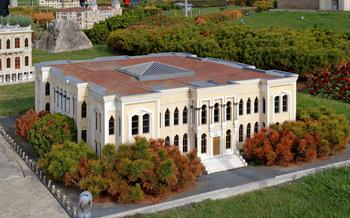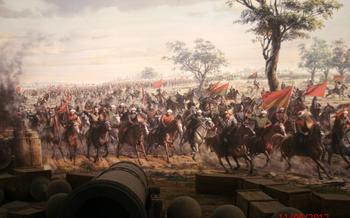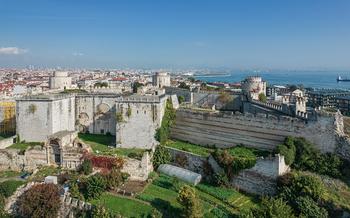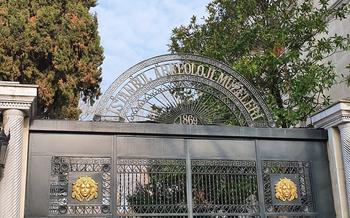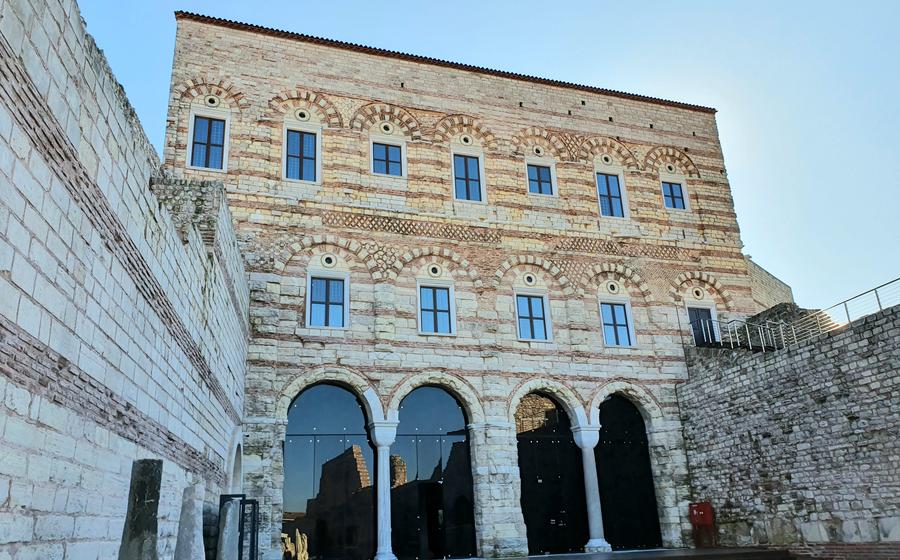
Tekfur Palace
- Tekfur Palace: A Historical Gem in Istanbul
- Exploring the Palace's Byzantine Origins
- Marveling at the Palace's Architecture
- Discovering the Palace's Mosaics
- Immerse Yourself in the Palace's Museum
- Unveiling the Palace's Hidden Stories
- Tips for Planning Your Visit
- Exploring the Neighborhood Around the Palace
- Capturing the Essence of the Palace
- Stepping Back in Time with Historical Reenactments
- Engaging in Interactive Workshops and Classes
- Delving into the Palace's Archaeological Significance
- Unveiling the Palace's Secret Passages and Chambers
- Insider Tip: Unveiling the Hidden Terrace
Tekfur Palace: A Historical Gem in Istanbul
In the heart of Istanbul's historic Sultanahmet district, nestled amidst other architectural wonders, lies the enigmatic Tekfur Palace. This palace, steeped in history and architectural significance, serves as a testament to the city's rich past. Its origins can be traced back to the Byzantine era, where it played a pivotal role as the residence of Byzantine emperors and their entourage. Over the centuries, it underwent transformations during the Ottoman period, serving as a royal residence and an administrative center. Today, the Tekfur Palace stands as a museum, inviting visitors to delve into its fascinating history and marvel at its intricate architecture and well-preserved mosaics. Conveniently located within walking distance from other major attractions, the palace offers an immersive experience, allowing visitors to step back in time and explore the layers of Istanbul's vibrant history.
Exploring the Palace's Byzantine Origins
The Tekfur Palace stands as a testament to the grandeur and artistry of the Byzantine Empire, which ruled over much of the eastern Mediterranean for over a millennium. During this period, Istanbul served as the empire's capital, known as Constantinople, and the palace played a pivotal role in the city's political, cultural, and religious life.
The palace's Byzantine origins are evident in its architectural style, which blends Eastern and Western influences. The exterior features intricate brickwork and stone carvings, while the interior boasts stunning mosaics depicting biblical scenes and imperial portraits. These mosaics, some of the finest surviving examples of Byzantine art, offer a glimpse into the empire's rich artistic traditions.
The palace also played a crucial role in the Byzantine court, serving as a venue for official ceremonies, receptions, and imperial councils. It witnessed the rise and fall of emperors, the plotting of court intrigues, and the shaping of Byzantine history. Many prominent figures, including emperors, empresses, and high-ranking officials, graced its halls, leaving an indelible mark on its legacy.
Exploring the Tekfur Palace's Byzantine origins is a journey through time, allowing visitors to immerse themselves in the splendor and intrigue of a long-lost empire.
Marveling at the Palace's Architecture
The Tekfur Palace stands as a testament to the architectural prowess of both the Byzantine and Ottoman empires. Its exterior facade showcases a harmonious blend of Byzantine and Ottoman styles, featuring intricate brickwork and decorative stone carvings. The palace's entrance, adorned with elegant arches and marble columns, invites visitors to step into a world of grandeur and history.
Inside the palace, visitors are greeted by a breathtaking array of mosaics, frescoes, and decorative elements. The walls are adorned with intricate mosaic panels depicting scenes from biblical stories, historical events, and imperial portraits. The floors are covered in colorful marble tiles, creating a vibrant and visually captivating tapestry.
The palace's ceilings are equally impressive, featuring intricate domes, vaults, and arches. The domes are adorned with stunning mosaics depicting religious and secular figures, while the vaults and arches display delicate floral and geometric patterns. The overall effect is one of awe and wonder, as visitors are transported back in time to the opulent era of the Byzantine and Ottoman empires.
The Tekfur Palace is not merely a historical site but also a work of art, showcasing the finest craftsmanship of its time. Its architectural features, both exterior and interior, are a testament to the skill and creativity of the artisans who worked on its construction.
Discovering the Palace's Mosaics
In Byzantine art, mosaics played a pivotal role in adorning religious and imperial structures. The Tekfur Palace is no exception, boasting an array of intricate and well-preserved mosaics that transport visitors to a bygone era. These exquisite artworks depict biblical scenes, historical events, and allegorical representations, offering a glimpse into the religious and cultural beliefs of the Byzantine Empire.
One of the most striking mosaics is the Deesis, located in the narthex of the palace church. This iconic depiction showcases Jesus Christ flanked by the Virgin Mary and John the Baptist, symbolizing their intercession on behalf of humanity. The vibrant colors and lifelike expressions of the figures exude a sense of divine presence and spiritual reverence.
Another notable mosaic is the Virgin Mary with Child, situated in the apse of the church. This serene and majestic representation portrays the Virgin Mary holding the infant Jesus, surrounded by a radiant halo. The mosaic's intricate details and symbolism evoke a sense of awe and devotion, highlighting the central role of the Virgin Mary in Byzantine Christianity.
In addition to religious themes, the palace mosaics also feature historical scenes and allegorical representations. The Triumph of Heraclius mosaic, for instance, depicts the Byzantine emperor returning to Constantinople after his victory over the Persians. The mosaic's intricate details and vivid colors bring to life the grandeur and triumph of this historic event.
The techniques and materials used in creating these mosaics are as remarkable as the artworks themselves. Skilled artisans employed a process called opus tessellatum, meticulously arranging small, colored tesserae to form the intricate designs and figures. The tesserae, made from glass, ceramic, or stone, were carefully selected for their color, texture, and durability, ensuring the mosaics' longevity and brilliance.
The mosaics of the Tekfur Palace are not merely decorative elements; they serve as a testament to the artistic prowess and religious fervor of the Byzantine Empire. By exploring these exquisite artworks, visitors can gain a deeper understanding of Byzantine history, culture, and spirituality, immersing themselves in the grandeur and splendor of this ancient civilization.
Immerse Yourself in the Palace's Museum
Established in 1964, the Tekfur Palace Museum houses a remarkable collection of artifacts and artworks that provide a glimpse into the palace's rich history and cultural significance. The museum's exhibits are meticulously curated, showcasing Byzantine mosaics, Ottoman-era ceramics, and other precious artifacts unearthed during archaeological excavations.
A highlight of the museum is the stunning collection of mosaics, many of which were originally part of the palace's intricate interior decorations. These intricate mosaics depict religious scenes, mythological figures, and historical events, offering a vivid glimpse into the artistic traditions of the Byzantine Empire.
Interactive exhibits and educational programs enhance the museum experience, making it an ideal destination for visitors of all ages. Children can participate in hands-on activities and workshops that teach them about Byzantine art and culture, while adults can delve deeper into the palace's history through guided tours and lectures.
The museum is fully accessible for visitors with disabilities, ensuring that everyone can enjoy the palace's treasures. Wheelchair ramps, elevators, and audio guides in multiple languages are available to facilitate a comfortable and informative visit for all.
Unveiling the Palace's Hidden Stories
The Tekfur Palace is not just a historical landmark; it is a treasure trove of hidden stories waiting to be discovered. As you wander through its chambers and corridors, you can almost feel the echoes of the past whispering secrets in your ears.
Legends abound about the palace's hidden chambers and secret passages, said to have been used by Byzantine emperors and Ottoman sultans for clandestine meetings and escapes. Explore these hidden spaces, and you'll be transported back in time, imagining the intrigue and drama that unfolded within these walls.
One of the most intriguing stories associated with the palace is that of Princess Anna Komnene, the daughter of Byzantine Emperor Alexios I Komnenos. Anna was a renowned historian and scholar who played an active role in her father's court. According to legend, she used a secret passageway to access the palace's library, where she spent countless hours studying and writing.
Another fascinating tale tells of the Ottoman sultan who used a hidden chamber to meet with his spies and advisors, discussing matters of state and plotting strategies for conquest.
As you explore the palace, keep an ear out for the whispers of the past. Let your imagination run wild as you piece together the stories of the people who once walked these halls, shaping the course of Istanbul's history.
Tips for Planning Your Visit
To make the most of your visit to the Tekfur Palace, careful planning is essential. Here are some tips to ensure a smooth and enriching experience:
-
Best Time to Visit: Aim for a weekday morning to avoid the crowds and experience a serene atmosphere. During the shoulder seasons (spring and fall), the weather is pleasant, and you can enjoy the palace grounds without the summer heat.
-
Recommended Duration: Dedicate at least two hours to thoroughly explore the palace's exhibits and marvel at its architectural details. This will allow you to immerse yourself in the history and culture it holds.
-
Guided Tours and Audio Guides: Enhance your visit with a guided tour led by knowledgeable experts who can provide insights into the palace's history and significance. Audio guides are also available, offering a self-guided experience at your own pace.
-
Facilities for Visitors: The palace offers basic amenities for visitors, including restrooms and a small cafe. However, it's advisable to bring your own snacks and water, as the cafe may have limited options.
Exploring the Neighborhood Around the Palace
The Tekfur Palace stands as a testament to Istanbul's rich history, and its surrounding neighborhood is equally captivating. A stroll through the cobbled streets reveals a tapestry of architectural styles, from Byzantine churches to Ottoman mosques, reflecting the city's diverse heritage.
In the immediate vicinity of the palace, visitors can marvel at the grandeur of the Kalenderhane Mosque, a 16th-century Ottoman masterpiece with its intricate tilework and elegant dome. Just a short walk away, the Church of St. Mary of Blachernae, with its stunning mosaics and frescoes, transports visitors back to the Byzantine era.
For those seeking a culinary adventure, the neighborhood offers an array of enticing options. Indulge in traditional Turkish cuisine at one of the many charming restaurants lining the streets, or savor the flavors of international fare at one of the hip cafes.
To delve deeper into the neighborhood's artistic side, visit the Istanbul Museum of Modern Art, showcasing a diverse collection of contemporary Turkish and international artworks. Alternatively, immerse yourself in the vibrant atmosphere of the Arasta Bazaar, a bustling marketplace where you can haggle for unique souvenirs and handicrafts.
Transportation options in the area are plentiful, with frequent trams and buses connecting visitors to other parts of the city. Alternatively, hop on a nostalgic ferry at the nearby Eminönü Ferry Terminal for a scenic ride across the Bosphorus Strait.
Capturing the Essence of the Palace
For photography enthusiasts, the Tekfur Palace presents a treasure trove of opportunities to capture stunning shots. The palace's intricate architecture, colorful mosaics, and picturesque surroundings provide a feast for the lens. To make the most of your photography experience, consider the following tips:
-
Choose the Right Lighting: The best time to photograph the palace is during the golden hours, just after sunrise or before sunset. The warm, diffused light during these times enhances the colors and textures of the palace, creating a magical ambiance.
-
Experiment with Angles: Don't limit yourself to straight-on shots. Explore different angles and perspectives to capture the palace's grandeur. Try shooting from a low angle to emphasize its imposing size, or from a high vantage point to capture the intricate details of the mosaics.
-
Use Filters and Editing: Don't be afraid to experiment with filters and editing techniques to enhance your photos. Subtle adjustments to contrast, saturation, and exposure can bring out the vibrant colors and details of the palace.
With a little planning and creativity, you can capture stunning photographs that will preserve the beauty and history of the Tekfur Palace for years to come.
Stepping Back in Time with Historical Reenactments
The Tekfur Palace occasionally comes alive with the sounds and sights of the past as it hosts historical reenactments that transport visitors back in time to the Byzantine era. These immersive events recreate significant moments from the palace's history, allowing visitors to witness scenes of royal ceremonies, courtly life, and important historical episodes.
The reenactments are meticulously researched and staged, with actors donning authentic costumes and using props and sets that accurately reflect the grandeur of the Byzantine era. Visitors can witness the arrival of foreign dignitaries, the celebration of religious festivals, and even the enactment of historic battles that shaped the destiny of the empire.
The reenactments are not only entertaining but also educational, providing visitors with a deeper understanding of Byzantine culture, history, and traditions. They offer a unique opportunity to step back in time and experience the vibrant atmosphere of the Tekfur Palace during its heyday.
Whether you are a history buff, a theater enthusiast, or simply someone who enjoys a unique and immersive experience, attending a historical reenactment at the Tekfur Palace is a must-do activity. Check the palace's website or local tourist information centers for upcoming events and ticket information.
Engaging in Interactive Workshops and Classes
For those seeking a deeper immersion into Byzantine art and culture, the Tekfur Palace offers a range of interactive workshops and classes. These educational programs provide hands-on experiences that allow visitors to learn about and create their own Byzantine-inspired artwork.
Mosaic-making workshops are a popular choice, where participants can create their own mosaics using traditional techniques and materials. Classes on Byzantine iconography teach the art of painting religious icons, using gold leaf and tempera paints. Visitors can also learn the secrets of Byzantine calligraphy, creating beautiful manuscripts using traditional tools and inks.
These workshops and classes are suitable for people of all ages and skill levels, making them a great activity for families and friends. They not only provide a fun and creative experience but also offer a unique opportunity to learn about Byzantine art and culture in a hands-on way.
Participants in these educational programs will gain a deeper appreciation for the intricate artistry and symbolism of Byzantine art. They will also leave with a unique souvenir to cherish, a creation that reflects their own creativity and the enduring legacy of the Byzantine Empire.
Delving into the Palace's Archaeological Significance
Extensive archaeological excavations have been conducted at the Tekfur Palace, revealing a wealth of artifacts and ruins that shed light on its construction and evolution over time. These excavations have provided valuable insights into the palace's Byzantine origins, as well as its subsequent transformation during the Ottoman era.
Archaeologists have uncovered remnants of earlier structures that predate the palace's construction, suggesting that the site has been continuously occupied since ancient times. Discoveries include foundations, pottery fragments, and coins, which have helped to piece together the history of the area and the development of the palace.
The excavations have also revealed hidden chambers and passageways, which may have served various purposes, such as storage, security, or escape routes. These discoveries have added to the intrigue and mystery surrounding the palace, inviting visitors to imagine the lives and activities that took place within its walls.
The archaeological findings from the Tekfur Palace have contributed significantly to our understanding of Istanbul's rich history and the evolution of its architectural heritage. They provide a glimpse into the city's past, allowing us to connect with the lives and experiences of those who inhabited this remarkable palace throughout the centuries.
Unveiling the Palace's Secret Passages and Chambers
Enhancing the aura of mystique surrounding the Tekfur Palace are its hidden passages and chambers, concealed within its ancient walls. These secret spaces, steeped in history and intrigue, were once used for various purposes, including escape routes, storage chambers, and even hiding places for valuable treasures.
Legends abound regarding these hidden chambers, adding to the palace's captivating allure. Tales speak of secret tunnels leading to distant locations or hidden vaults containing forgotten riches. While the exact nature of these chambers remains shrouded in mystery, their existence is undeniable and adds an air of excitement to exploring the palace.
Exploring these hidden spaces requires caution and an adventurous spirit. Some passages may be narrow or dimly lit, while others might lead to unexpected and secluded areas. Visitors should be mindful of their surroundings and follow safety guidelines when venturing into these hidden realms.
Unveiling these secret passages and chambers is a unique opportunity to delve deeper into the palace's rich history and uncover its hidden narratives. It's a journey into the unknown, where imagination and curiosity intertwine to create a truly unforgettable experience.
Insider Tip: Unveiling the Hidden Terrace
For a truly unforgettable experience, make sure to explore the hidden terrace tucked away within the Tekfur Palace's walls. This secret spot offers unparalleled panoramic views of Istanbul's iconic landmarks. Imagine standing atop this hidden gem, with the Hagia Sophia, the Blue Mosque, and the sparkling waters of the Bosphorus Strait stretching out before you.
To reach the hidden terrace, ask a museum attendant for directions, as it is not well-signposted. Once you find the discreet entrance, climb the narrow, winding stairs that lead to this hidden gem. The effort is well worth it as you emerge onto the terrace and are greeted by a breathtaking vista that will leave you in awe.
The terrace provides a unique perspective from which to admire the architectural wonders of Istanbul. The Hagia Sophia's majestic dome seems to float effortlessly above the cityscape, while the Blue Mosque's minarets pierce the azure sky. The Bosphorus Strait, a shimmering ribbon of blue, winds its way through the heart of the city, connecting East and West.
As the sun begins to set, the sky transforms into a canvas of vibrant colors, casting a golden glow over the city. This is the perfect time to capture stunning photographs of Istanbul's skyline. With the hidden terrace as your vantage point, you'll have the opportunity to create memories that will last a lifetime.





